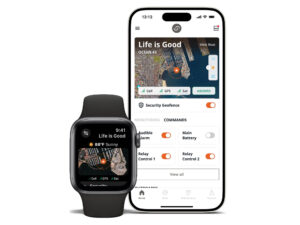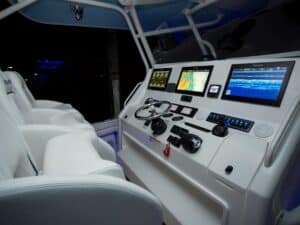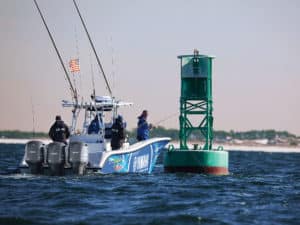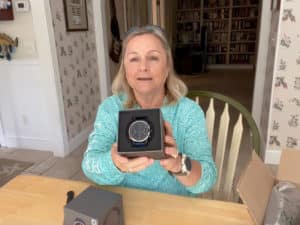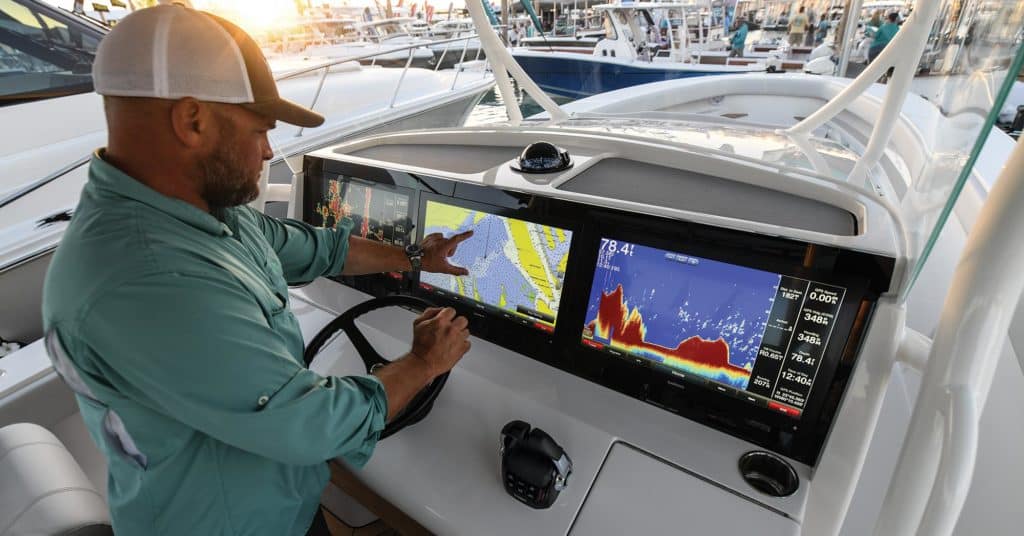
Above: Three Garmin displays decorate the helm of the Jupiter 43. Sleek flush-mounted screens can now give larger center consoles the glass-bridge feel of traditional inboard sport-fishing boats.
As technology leaps and bounds past our expectations, our what-ifs suddenly seem realistic. What if I could gesture-control my autopilot? What if I could look at the water column in 3D? What if I could monitor all of my boat’s systems on one display screen?
Believe it or not, those dreams have become factual in the marine-electronics world. To find out what kinds of amazing gear might be possible for today’s offshore fishing boats, I asked manufacturers to suggest dream helms for two sizes of vessels: 25- to 28-footers and 38- to 42-footers.
In some cases, my query went to boatbuilders who install this gear at the factory; in others, to electronics manufacturers (those who don’t work directly with boatbuilders). Because MSRP per item can vary greatly from package pricing, and because all of these helms require ancillary antennae, networking hardware, charts and wiring, I am not listing the dollars and cents. Suffice it to say that some of these helms reach the mid-five-figure range.
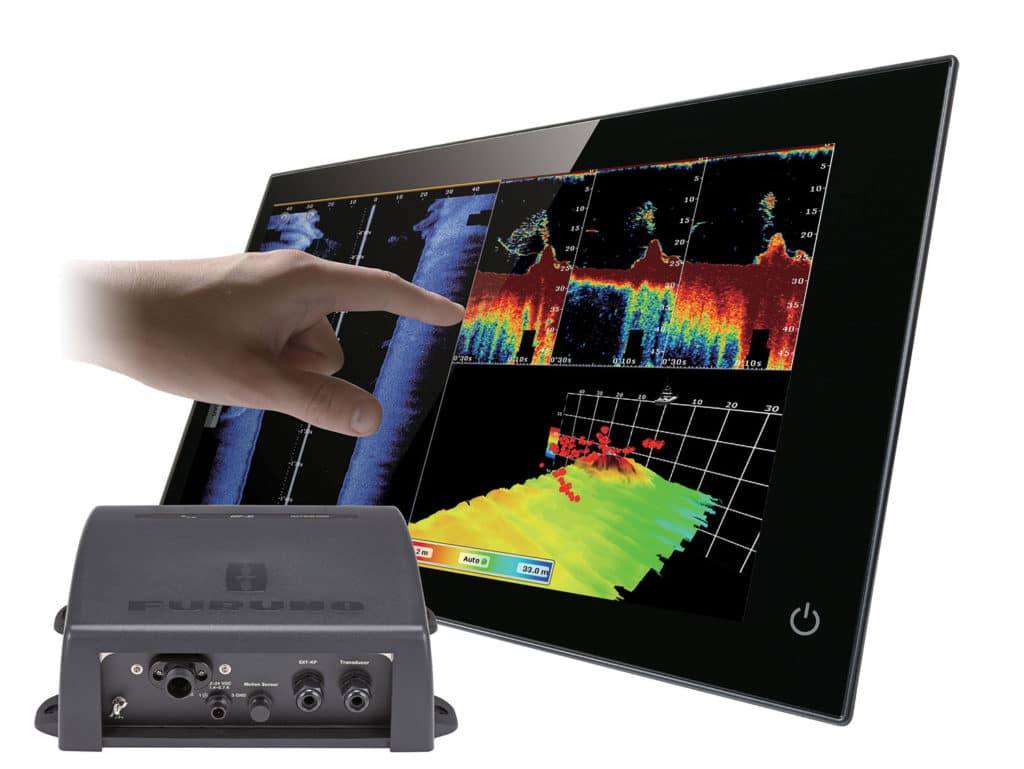
FURUNO
Furuno chooses not to work directly with boatbuilders, instead supplying its dealers with product. For a 26-foot fishing boat, Furuno described this package as a dream helm:
- Two TZtouch2 (TZTL12F) 12-inch displays
- DRS6ANXT radar with 3.5-foot open array
- DFF3D (3D) multibeam sonar black box
- 165T-50/200-SS260 — combo transducer for DFF3D and 50/200 kHz internal fish finder
- NavPilot 300/PG autopilot with heading sensor
- GP330B external GPS sensor
- BBWX3 Sirius/XM satellite weather antenna
“This package offers the ultimate flexibility for this size boat with limited dash space,” says Jeff Kauzlaric, Furuno advertising and communications manager. “It features the 12-inch TZtouch2 multifunction display with a chart plotter, RezBoost 50/200 kHz fish finder, DFF3D multibeam sonar and a solid-state Doppler open-array radar. We added in the new NavPilot 300 autopilot, which features rich fish-hunting steering modes and the new gesture-control capabilities.” Gesture control means a captain can simply press a button on the handheld Bluetooth remote and point it in the direction he wants to go, and the autopilot follows.
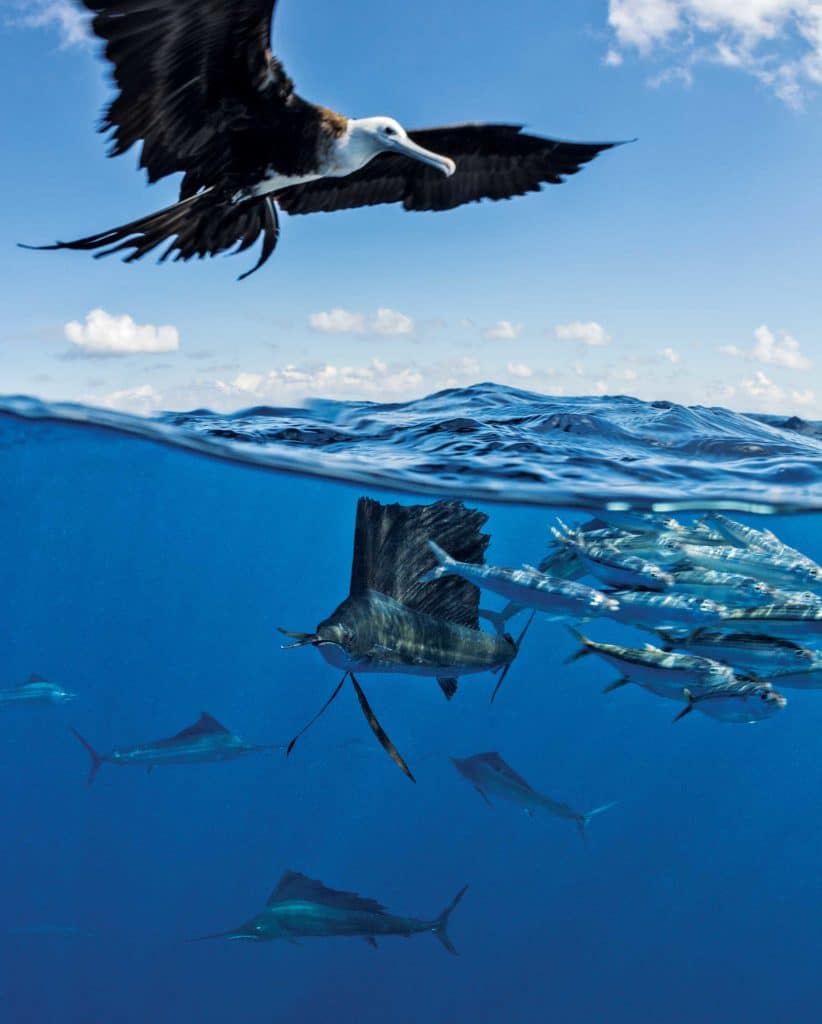
Furuno listed additional sensors that add to navigational safety and assist with other crucial fishing data, including a Sirius/XM weather receiver and an external GPS sensor for redundancy. “Whether you’re fishing for kingfish, tuna, stripers or bottomfish, this package will put you on the fish,” Kauzlaric says. “Though the DFF3D is a deepwater side-scanning sonar that paints a 3D history, it’s right at home in the bays and inland waterways, helping to see fish schools and predators with its 120-degree port-to-starboard view.”
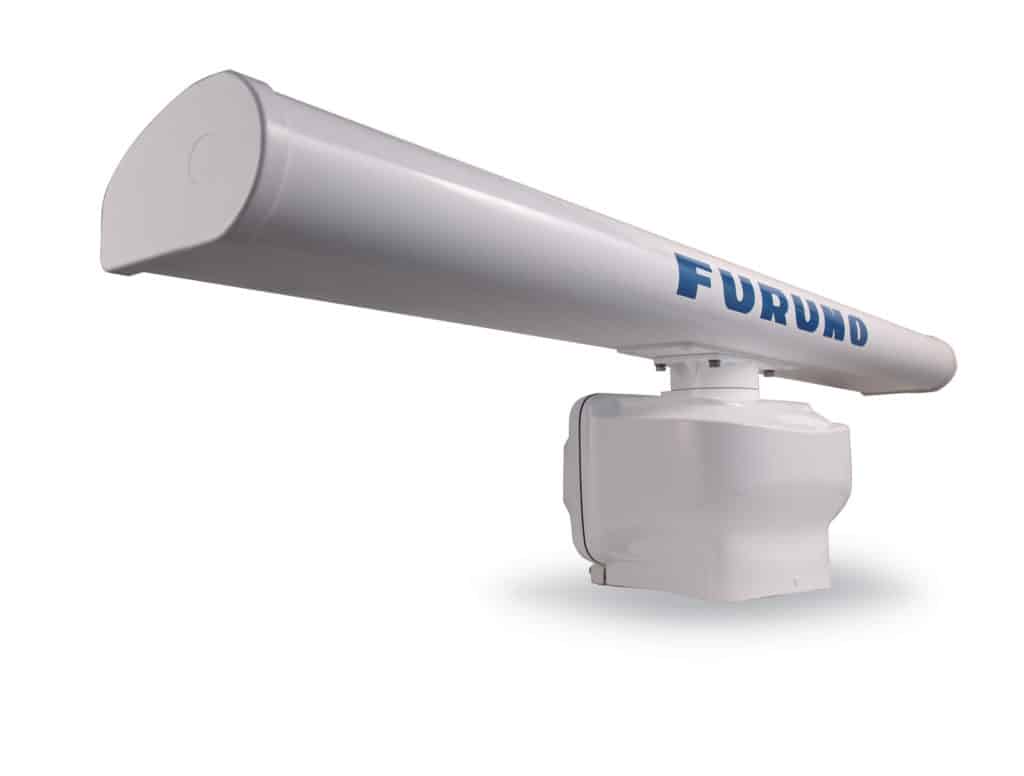
For a 40-footer, Furuno listed this package:
- TZtouch2 black box (TZT2BB) with dual MU190T touch displays
- DRS25AX X-Class radar with 6-foot antenna
- DFF1-UHD TruEcho CHIRP fish finder
- DFF3D (3D) multibeam sonar
- 165T/265LH-PM488 combo transducer DFF3D and CHIRP
- NavPilot 300 AutoPilot
- GP330B external GPS sensor
- FA50 Class B AIS transponder
- BBWX3 Sirius/XM satellite-weather receiver
- FI70 instrument/data repeater
- SC30 satellite compass
- FI5002 NMEA2000 junction box
- HUB101 Ethernet hub
- MCU004 remote control
“This is the ultimate fishing package that offers everything, starting with the basics of a chart plotter, high-powered bird-finding radar and TruEcho CHIRP fish finder,” Kauzlaric says. “From there, we add in the DFF3D multibeam sonar, which gives you 120 degrees port to starboard of 3D sounding images. We added in the new NavPilot 300 autopilot (described for the smaller-boat package), and we combined that with a satellite compass to give the best possible position fix, creating incredible accuracy for the autopilot and radar overlays.”
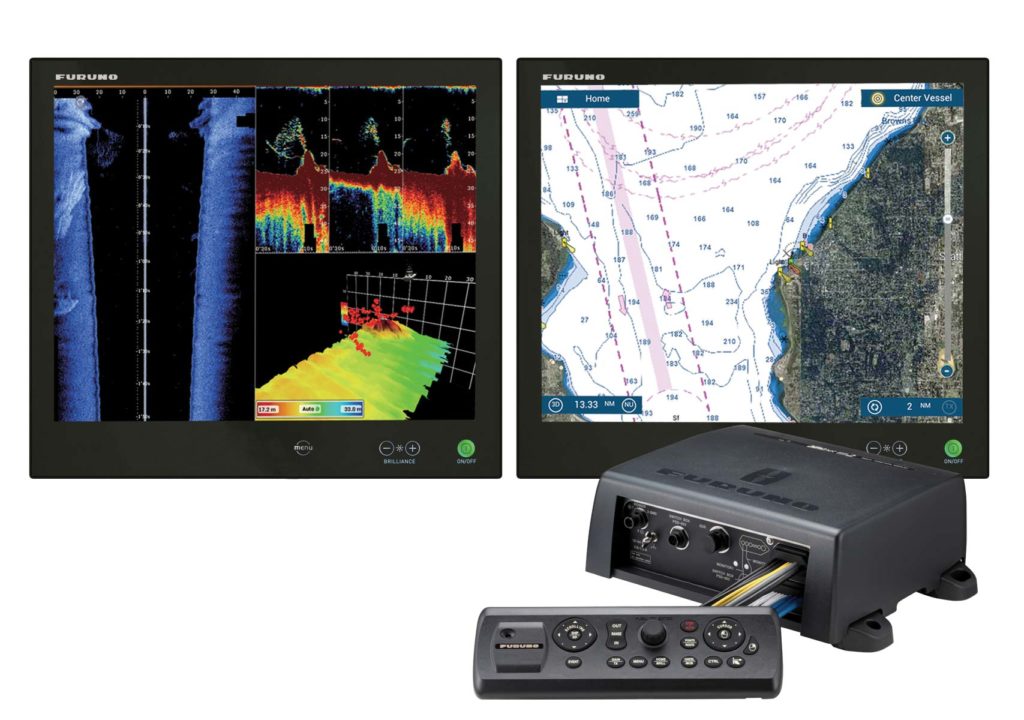
Kauzlaric suggested Furuno’s high-powered bird-finding radar, the DRS25AX X-Class radar, for this discriminating, hardcore fisherman. “With this radar, you can scout out locations based on birds feeding at a distance, farther than you can see with your eye or binoculars,” he says. “The fish-finding equipment in this dream package covers all possible fishing types. For midlevel tuna, dolphin, kingfish and even bottomfish, the DFF1-UHD will get you to the right depths and help you separate the individual predator fish from the bait.”
Additional sensors include an AIS transponder, Sirius/XM weather receiver, FI70 instrument/data repeater and an external GPS sensor for redundancy.
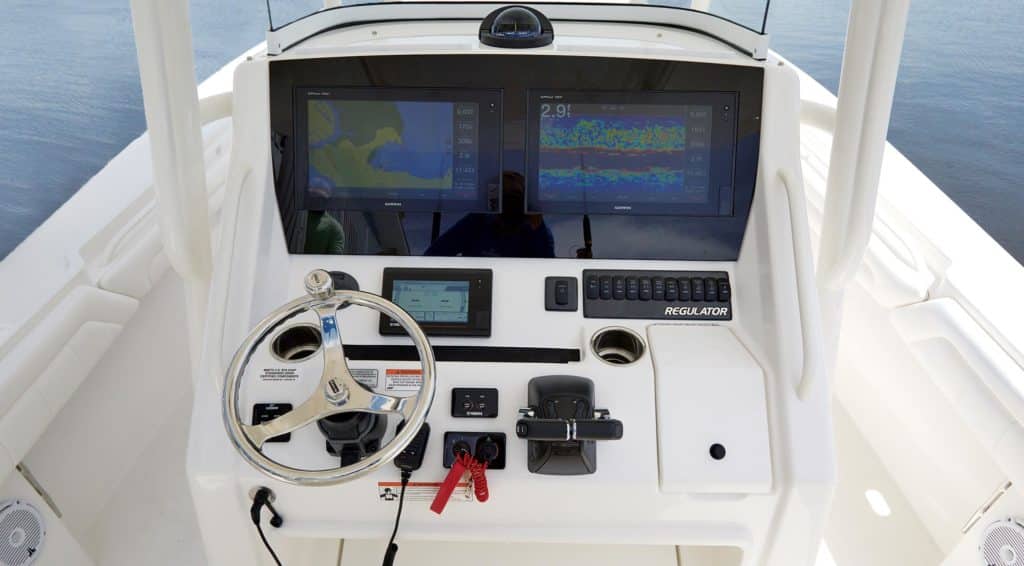
GARMIN
Garmin works with a large number of boatbuilding partners. For this article, I chose to ask the folks at Regulator Marine to detail a dream package for their 28-foot center console and Scout Boats to tell me how they’d rig their 42-foot LXF.
“The 28, for us, is one of our absolute best-selling boats,” says Regulator co-owner Owen Maxwell. “We started off the year including the same [electronics] packages on the 28 as we do on the 25. But our customers forced us to offer bigger-boat packages on the 28 — in this case, going from two 12-inch to two 16-inch Garmin 7616 displays.”
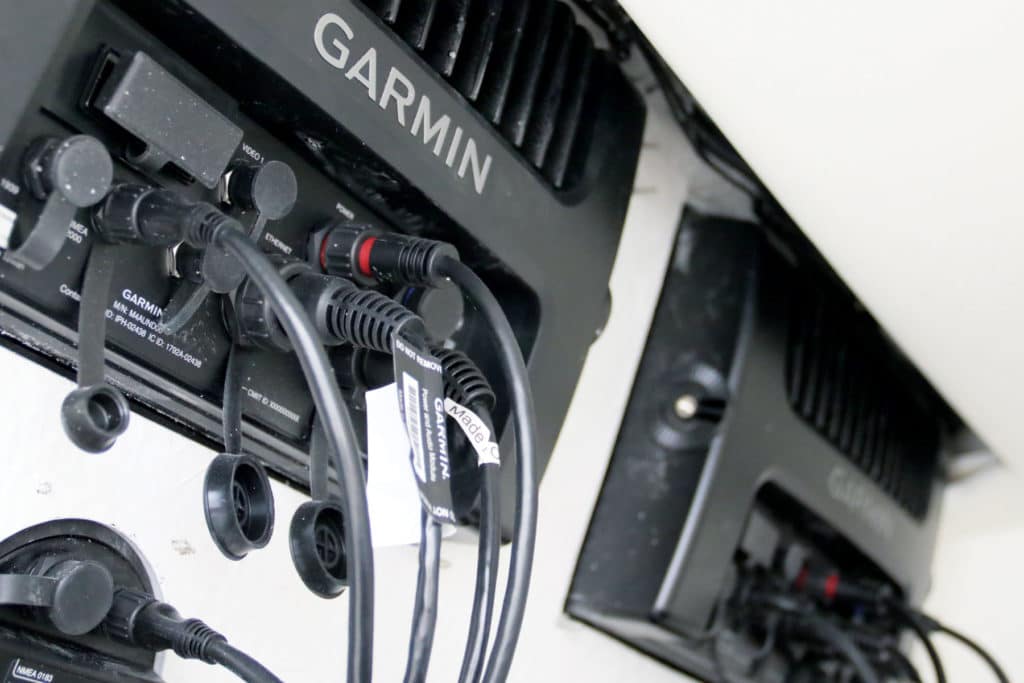
Anglers wanted the larger units so they could most easily see information at a glance. Maxwell says Regulator crafts the helm so the black touchscreens mount flush with the dash, creating a clean look.
The 7616s pair with an Airmar B265 LH (low-high chirp) through-hull transducer. “We like the LH for our customers who are deep-dropping. That low side will really get down deep (3,000 feet is the depth capability),” Maxwell says. “The chirp image is just a better, more-defined image than the nonchirp.”
If customers want a shallow-water transducer, they can add an Airmar B60 tilted through-hull. “On all of our boats 25 and up, we have the transducer pocket molded into the hull on the keel,” he says.
The 28s also feature a Garmin GMR 424 xHD2 4 kW 4-foot open-array radar or an optional 6 kW 4-foot version, and a GHP Reactor autopilot that enables drive-by-wire control. “We’re installing the Optimus EPS power-steering system on all of our models. It’s plug-and-play with the autopilot,” he says.
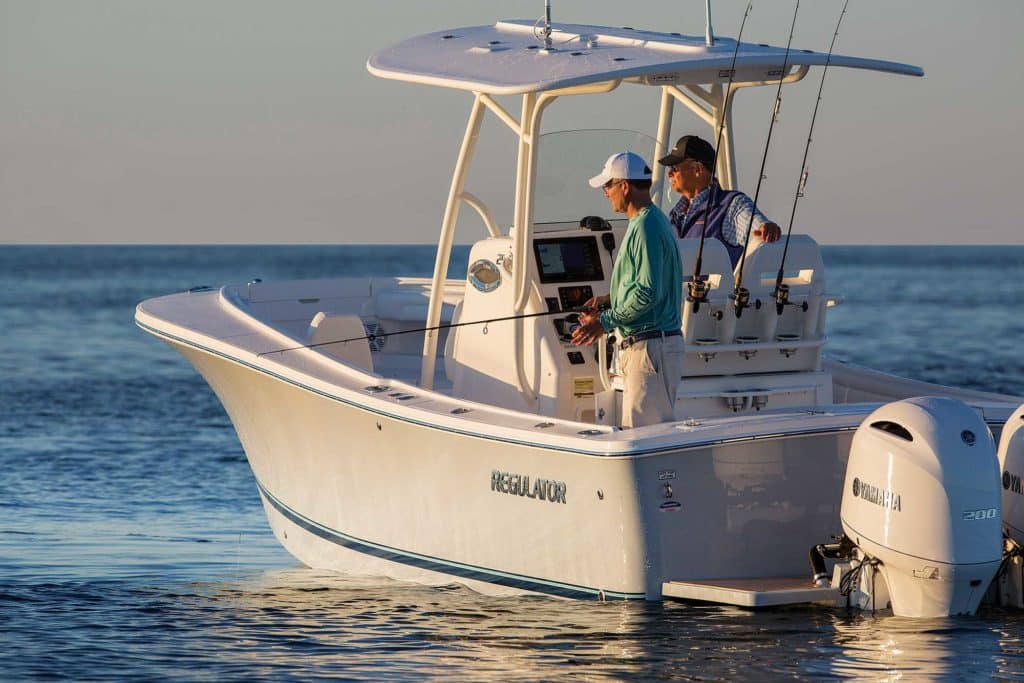
Additionally, Regulator installs a Garmin 210 VHF radio, which comes with an AIS receive function. “So on your display, you can see the boats around you on-screen,” he says. For musical entertainment, Regulator offers Polk Marine systems that interface with the Garmin displays. A final factory option is the GXM 53 Sirius/XM weather module.
Regulator does not currently install digital-switching systems. However, because Garmin recently bought the parent company for the EmpirBus systems, Maxwell predicts digital switching will soon proliferate.
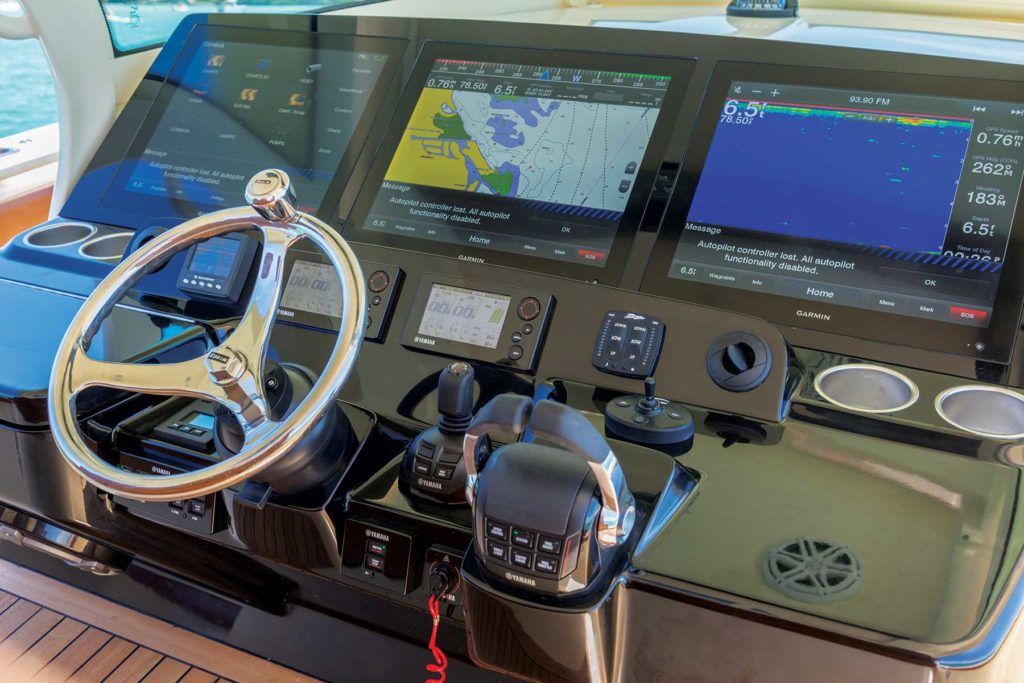
A bigger center console such as the Scout 420LXF obviously offers anglers more room to spread out the high-tech gear. “The 420LXF features a centerline helm, which allows for excellent electronic-screen visibility directly in front of the captain, but also peripheral screens just off to port and starboard that are easily viewed and used without shifting position,” says Josh Slayton, Scout product specialist. Three Garmin 8617 17-inch displays span this helm, offering a glass-bridge-like feel. “By utilizing CZONE digital switching, the rest of the helm is left available for more-functional use,” Slayton says.
For transducers, Slayton chose the Airmar B175H (high-frequency) and B175L (low-frequency) chirp transducers for offshore fishing. “Adding a Garmin CV51M-TH transducer would give you offshore and coastal down-view and side-view capabilities, painting structure as clearly as possible,” he says.
For radar, he chose the GMR 1226 xHD2. “I prefer the 6-foot open array for more-precise targeting over the 4-foot version, but I can’t really justify the benefit on a center console hardtop from the larger 25 kW model, so the 12 kW is great.”
He would install a Garmin VHF300 with an AIS 600 module for two-way AIS transmission. He’d add a second VHF300 and leave it unattached to AIS so he could monitor local fish talk.
If the boat came with Mercury outboards, “then I would use their autopilot system built into the joystick. If it was a Yamaha package, then I would use the Garmin Reactor autopilot system.”
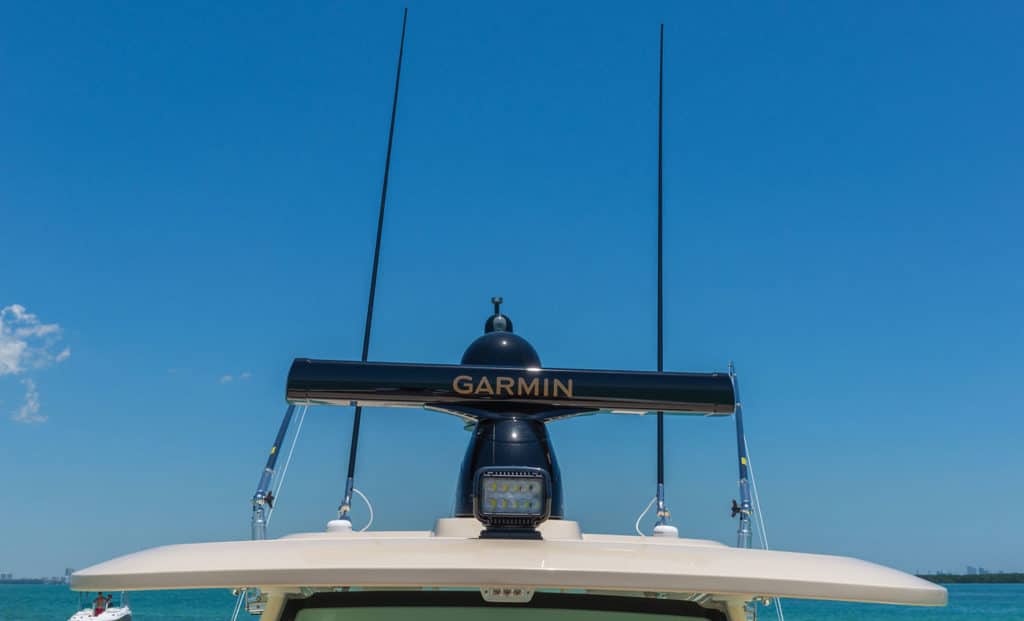
The perfect helm would also utilize a FLIR thermal camera — an M625S (high-resolution, gyro-stabilized), which would be controlled from the joystick or from the Garmin touchscreen, he explains. Slayton also says he would integrate several Garmin VIRB XE video cameras, linking them via local Wi-Fi. “This allows me to position two cameras facing aft and at the deck while trolling offshore. Once a fish is spotted in the spread, I can instantly tap ‘record’ on the Garmin helm screen and begin saving the action.”
Slayton would also mount a KVH satellite TV3 system on the 420’s hardtop. The data would feed through HDMI to the Garmin screens. The sound would feed to the Fusion stereo head unit on its own aux input, “so I could be watching March Madness basketball and listening to Dick Vitale make his play-by-play call.”
For additional entertainment, Slayton would place a Garmin GXM 53 antenna on the hardtop for XM radio and satellite weather.
“Just above me to port and starboard, there is room for Garmin 942xs displays on each side. These two screens would be used for a variety of additional cameras and electronics. I would put one Garmin GC 10 [camera] in the cabin so I could keep an eye on the kids napping or playing. I would put another Garmin GC 10 facing aft so I could see behind me when docking.
“As crazy as it sounds, I would also integrate a Garmin gWind transducer. This mounts on the hardtop, and it’s nice to know what the wind speed is sitting at the dock.
“Depending on the location of the vessel, I would also add an underwater camera in the transom. I have used this to spot active reefs as well as just for the fun of looking under the boat while at anchor as an onboard entertainment screen. I’ve used the Lumi-Cam TIX 402 from Lumishore.”
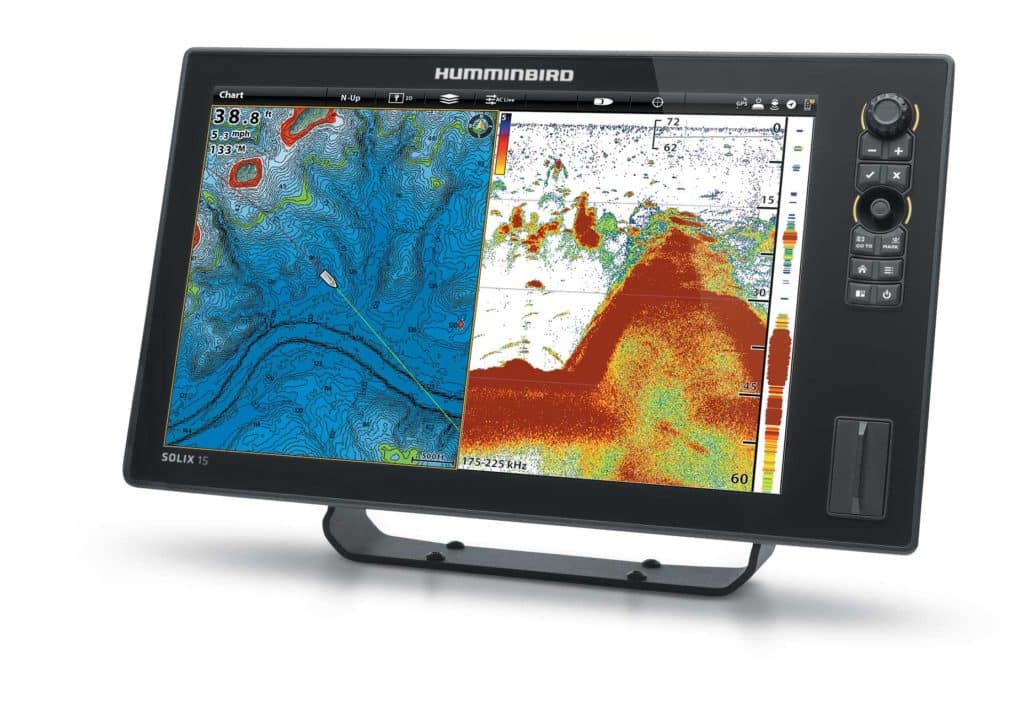
HUMMINBIRD
Humminbird generally targets smaller boats in the offshore‑fishing market, so that company’s package focuses on a typical 26-foot vessel. Here’s what the company would install aboard:
- Solix 15 CHIRP Mega SI GPS
- Solix 15 CHIRP GPS
- XP 14 20 200/83 kHz transducer
- AS GPS HS GPS/WAAS receiver with heading sensor
- HB 2124 CHIRP radar (21-inch dome)
Assuming the boat’s dash allows, the two Solix units would mount flush in the helm and connect using an Ethernet hub. The radar and a Minn Kota trolling motor, such as the Ulterra with i-Pilot Link, would also network through the hub.
The GPS receiver would connect to one unit, providing heading data to the network. Humminbird recommended a through-hull XP 14 20 dual-frequency transducer, or an Airmar B175HW chirp transducer, depending on fishing needs.
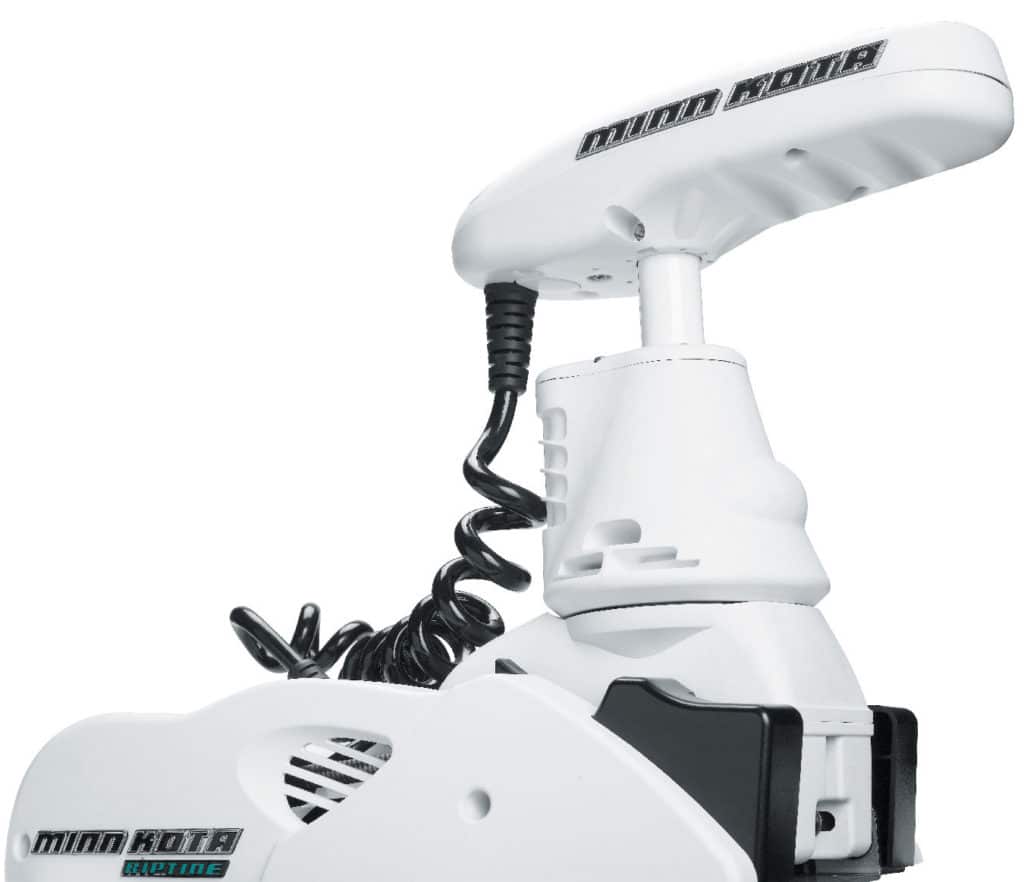
“We chose this package because it provides boaters and anglers with total boat control, making their job easier and at the same time giving them more time to fish due to less time required to drive the boat or deploy the anchor,” says Bill Carson, Humminbird field marketing manager. “This setup is what our staffers at Humminbird choose for their own boats, no questions asked.”
This “do-it-all” package provides radar that aids navigation, especially during spring when coastal waters can experience heavy fog, Carson says. “The Solix SI unit has Mega imaging, which is great for 40 feet and less for the nearshore channel opportunities, and offers 800 kHz and 455 kHz for [imaging in] deeper water.”
The system also provides AutoChart Live for real-time onboard mapping. With NMEA 2000 capability, the engines can connect to the Solix.
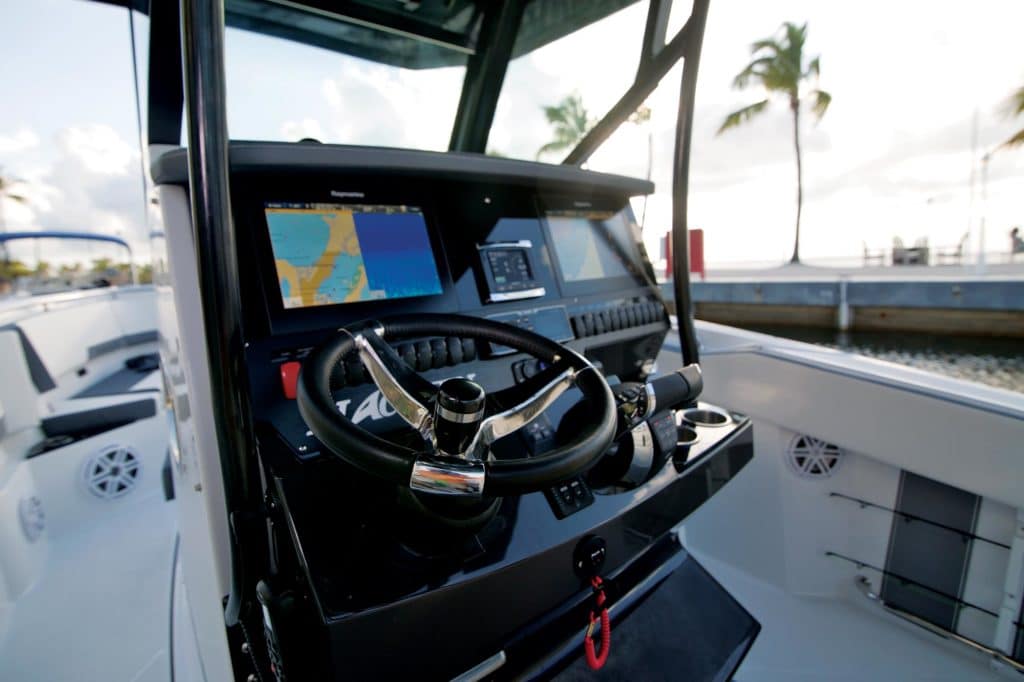
RAYMARINE
Blackfin says a Raymarine dream helm for its 272 center console would include:
- Two Axiom 12-inch multifunction displays
- Ray260 VHF
- Quantum 2 radar
- CP370 digital sonar module
- B164 1 kW through-hull transducer
- RV-220 RealVision 3D through-hull transducer
- T300 thermal camera
- EV-1 autopilot
“This package will make any 25- to 28-foot boat usable for any type of fishing the customer might want to do,” says Mason Cummings, Blackfin engineering manager. “This will satisfy everyone, from the tournament fisherman to the customer who might fish only a few times a year.”
The Axioms offer RealVision 3D views, with the accompanying transducer, which makes finding and fishing structure simple, Cummings says. The CP370 sonar module and Airmar B164 transducer (50/200 kHz) add clear target detection to 5,000 feet, and “are a must for anyone bottomfishing or trying to look at the bottom in more than 600 feet of water depth,” he says.
Raymarine’s brand-new Quantum 2 radome features Doppler and wireless technology. The former enhances collision avoidance by showing approaching targets in red, and the latter eliminates a lot of cabling through hardtops and consoles.
The Ray260 modular VHF keeps the dash clean because only the handset and loudspeaker mount at the helm; the base unit mounts belowdecks. “This is easily integrated into the system by a Raymarine SeaTalk hub,” Cummings says. “This can also be upgraded to have more than one handset should the customer require it.”
Cummings also recommends a thermal camera for navigating at night and in early-morning fog. The T300 features pan, tilt and zoom, and is stabilized.
And finally, an autopilot system really assists captains during long runs and when they need to direct traffic aboard while maintaining watch.
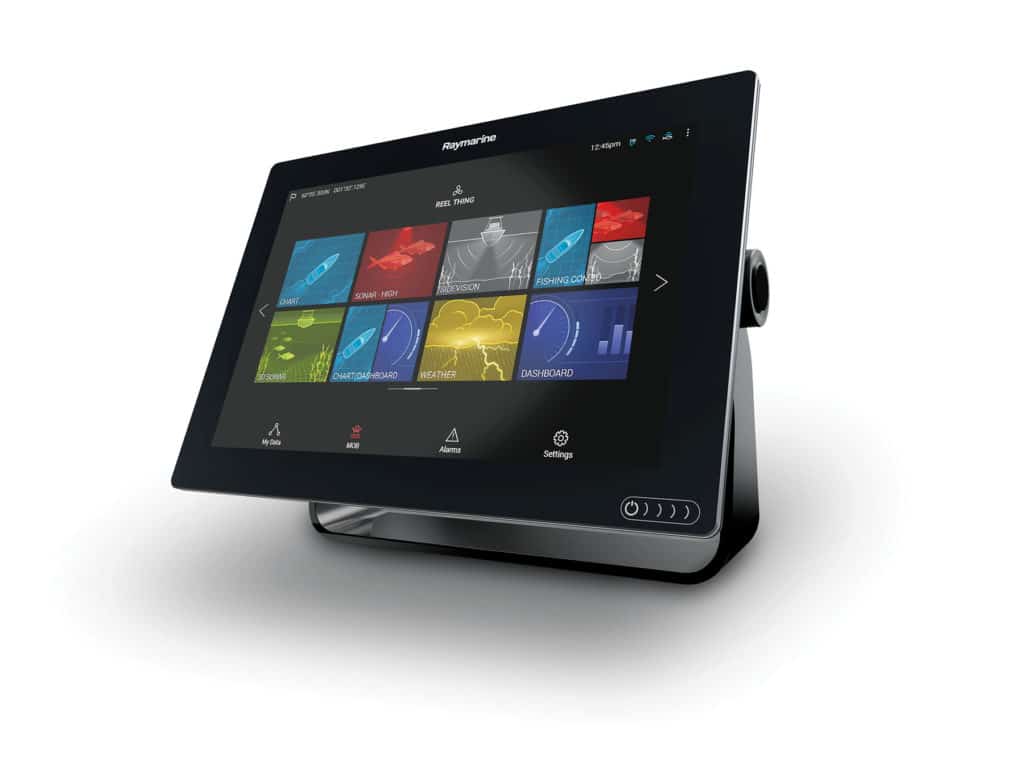
Boston Whaler takes a custom-build approach to outfitting its 420 Outrage for potential clients, says Wil Rogers, director of large-boat sales. But in many situations, the first priority is plenty of screen real estate. The 420’s broad helm face accommodates triple 16-inch, multitouchscreen Raymarine gS165 glass-bridge displays.
Whaler then offers a CP470 chirp sonar module in the package, but some buyers choose to upgrade to a top-of-the-line CP570, which features superior target separation and a wide spectrum of frequencies with greater sensitivity.
The CP570, capable of reading depths to 10,000 feet, is compatible with a variety of Airmar transducers that offer low/high, low/medium or medium/high frequency bands. Whaler creates fiberglass pockets for flush-mounting these units.
Interfacing with the gS units, a Raymarine HD color 12 kW open-array radar — available in 4- or 6-foot sizes — provides anglers with plenty of bird-finding power.
Thermal and IP cameras also play a key role aboard the 420. Whaler generally integrates a FLIR M625S or M324S gyro-stabilized pan/tilt thermal camera facing toward the bow. Belowdecks, Whaler installs thermal cameras to monitor the bilge and mounts IP cameras on deck level so the captain can watch the cockpit and other locations.
Read Next: Choose the Right Sounder for the Way You Fish
For communication and safety, Whaler will begin installing the new Ray90 VHF radio, which debuts this spring, to replace the Ray260. The 90 is a modular system that offers a wireless handset. Most owners also request an AIS system that sends and receives, such as the Raymarine AIS650.
Because Whaler is owned by the Brunswick Corporation, which also enfolds Mercury Marine, Whaler generally installs a Mercury joystick-piloting system, which comes with its own autopilot capabilities. Whaler also began its own boat-monitoring system called Whaler Watch, which interfaces the networked boat systems through external devices such as iPads and iPhones.
Using either CZone or EmpirBus, Whaler employs digital switching so everything electrical, including the highly popular Seakeeper gyro-stabilization systems, can be controlled through the helm displays.
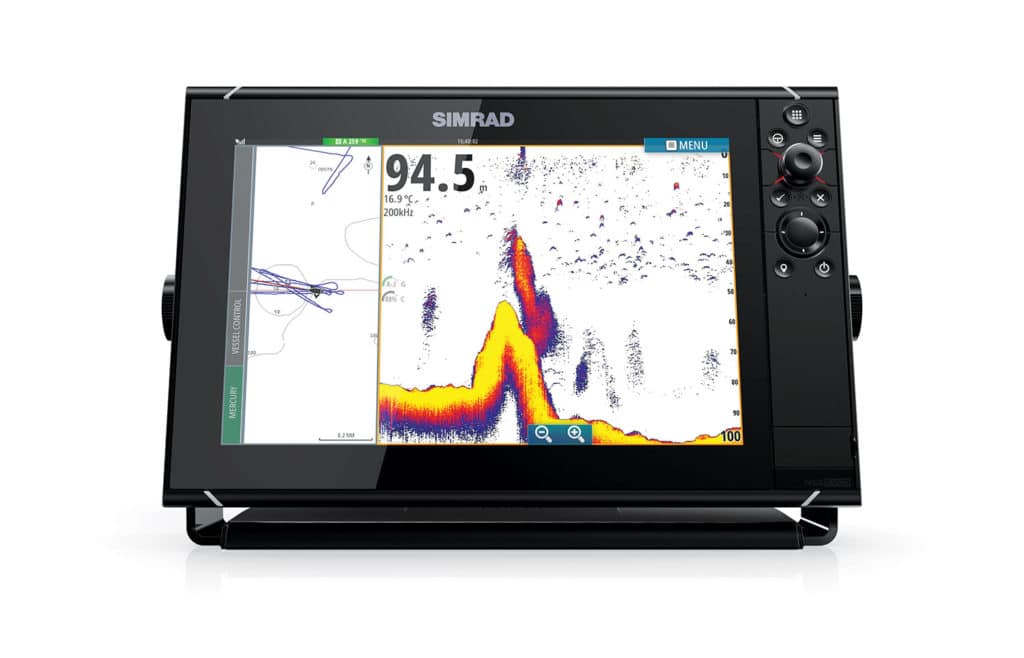
SIMRAD
While Simrad works with a variety of boatbuilders, most I talked to about 25- to 28-foot builds suggested they offer a limited package, allowing dealers to provide extra peripherals. So Simrad tournament captain Mark Maus suggested an optimal helm.
“This is for the hardcore fisherman who likes to find birds at a distance in search of bait pods,” he says. “The s5100 will allow the B275LH transducer to show fish in the water column to great depths, and never lose bottom lock at 2,000 feet while running in good conditions. Highlights include the NSS evo3 in the 12-inch size, which should fit 25- to 28-foot boats, 10 kW radar for bird spotting, 3D StructureScan with side-scan sonar to locate the bait and structure, and an AIS transmitter for safety. This would be my dream setup on a boat of that size.”
- Two NSS evo3 12-inch displays (GPS, sounder, Wi-Fi, HDMI out, Insight charts), space permitting
- S5100 chirp sonar module
- StructureScan 3D module with through-hull low/high chirp transducer
- Airmar B275LH-W (low/high wide) through-hull transducer
- TXL-10S-4 10 kW 4-foot open-array HD digital radar
- AP44 VRF autopilot
- NAIS-500
- RS35 VHF radio with AIS
- Track Wi-Fi kit (security and tracking system)
- SonicHub2 marine audio
- WM-3 Sirius/XM module
- GS25 antenna with built-in rate compass
SeaVee — like many of the boatbuilders included here — accommodates several major electronics brands, including Simrad. “By the time they get to us, well into 90 percent of customers have a pretty good knowledge base,” says John Caballero, SeaVee marketing director, “which translates into what they want in their boats.”
To build a Simrad dream helm for the SeaVee 390Z, the company talks through the customer’s needs for fishing and navigation, and gauges how much redundancy he or she might want. The most popular systems begin with twin 16-inch NSS evo3 displays. That setup leaves room at the helm for other devices and controls, Caballero says.
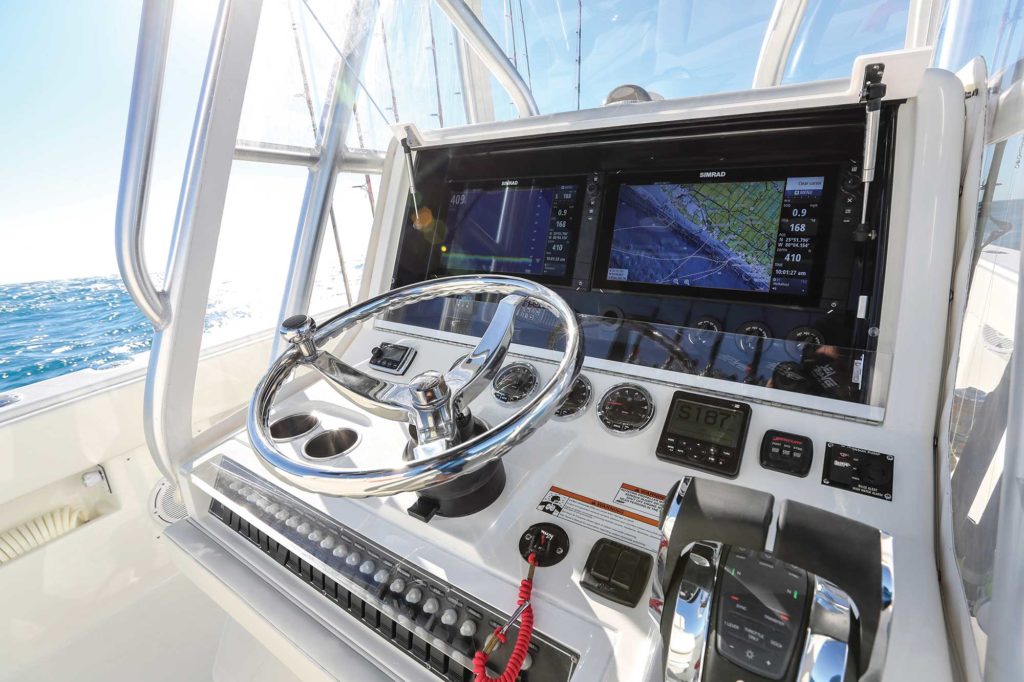
The NSS evo3 units offer multitouch touchscreen and keypad controls, and they network with Simrad’s s5100 chirp sonar module, which offers three fully independent sonar channels to run three chirp frequency ranges. SeaVee generally installs a 1 kW Airmar B275LH-W, although it will glass in transducers up to 3 kW, based on customer desires.
“The vast majority of our boats have a radar system. I like the Halo-4 for overall performance. It uses very low power,” says Caballero.
The most popular VHF radio installed at the factory is the ICOM M506 with an external speaker. Simrad electronics also display Mercury engine information using the Mercury VesselView Link digital interface.
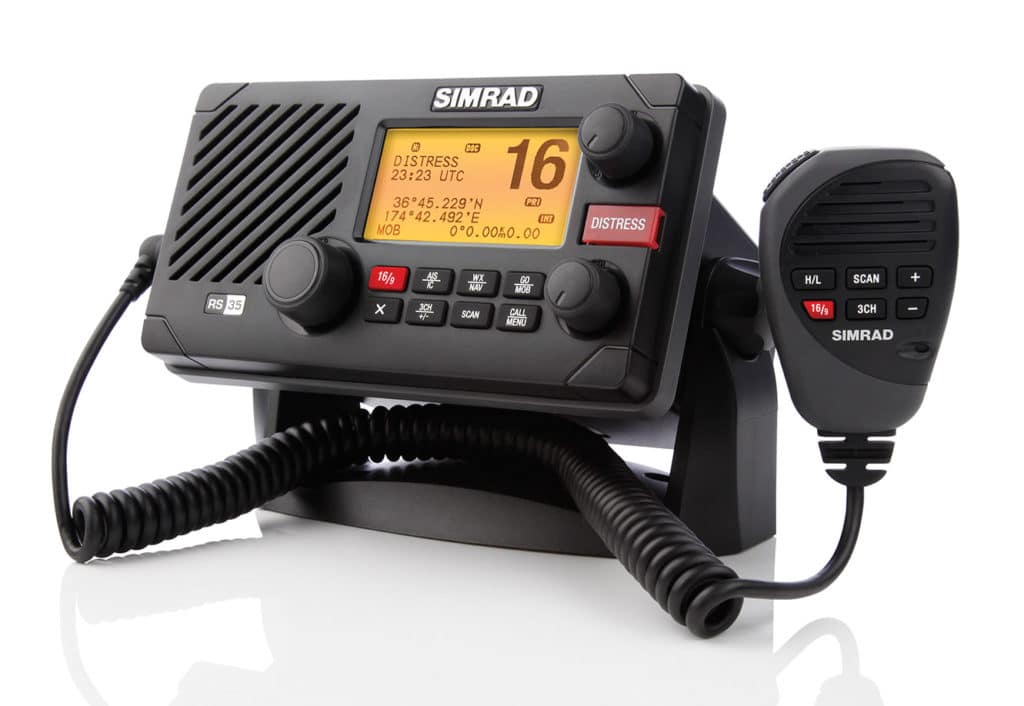
Caballero is a believer in the SeaStar Optimus electronic power-steering systems. Add in a joystick with heading control for electronic anchoring and autopilot functions.
One other ease-of-use piece of equipment SeaVee often recommends is the remote keypad (OP50) for the Simrad units. With the keypad mounted near the wheel, the captain can merely drop one hand to adjust plotter gain or range while running.
Other popular peripherals include a JL Media Master control head for audio that interfaces with the evo3s, a Sirius/XM weather module, a Globalstar Sat-Fi unit, and FLIR cameras such as the M200.
“In the early days, you had gaps in functionality or clunky operation; those days are over,” Caballero says. “These machines are adaptable. They have advanced software. You can optimize this equipment, and set up for whatever scenarios you’re in, such as trolling or bottomfishing. You get great performance throughout the entire water column.”

